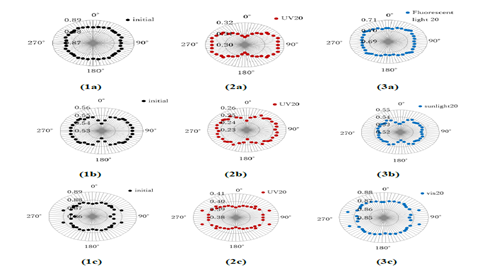Introduction
Energy conversion from electricity to
light is indispensable to our lives because we cannot live by sunshine alone.
There have been many reports of fires causing lighting appliances. Overheating
of incandescent light bulbs causes flammable materials to ignite [1,2],
fluorescent lamp (having mercury issue [3]) fixtures have deteriorated in their
sockets, electrical stabilizers have ignited electricity, and conventional
fluorescent light fixtures have LED bulbs attached to them [4]. Of course, the
new method has advantages such as energy saving and environmental aspects. On
the other hand, for the conversion of energy from light to electricity,
practical use and research and development of solar cells are progressing.
However, there is a problem that the new artificial light source does not work,
and it may not be possible to use it in a scene where sunlight cannot be
obtained (for example, a calculator under a fluorescent lamp). Therefore, as an
example of testing the possibility of replacing the light source, a model
experiment was performed using azobenzene (AZ),
which is a typical photochromic dye [5].
Discussion
Test samples
was prepared by mixing of 1 mL of AZ (0.05
mM) and PMMA (10% w/w) DMF solutions (0.05 mM) and casting on glass slides at
50℃ to form sample films ((1a-1c) trans-AZ with random orientation). Linearly
polarized UV light (generated by Xe lamp and filtered only for < 450 nm) was
irradiated to them for 20 min ((2a-2c) cis-AZ aligned
in anisotropic orientation). Polarized electronic spectra were measured before
(2a-2c) and after visible light ((3a) fluorescent lamp (Figure 1), (3b)
solar sunlight, and (3c) natural (unpolarized) halogen lamps filtered only for
>400 nm) irradiation for 20 min and compared with two parameters, S =
(Aparrallel - Aperpendicular) / (2Aperpendicular + Aparrallel) and R = Aperpendicular / Aparrallel where Aperpendicular and Aparrallel are absorbance at polarizer perpendicular
to or parallel to the electronic vector of polarized light for irradiation.
Ideally isotropic samples exhibit S = 0 and R =
1 [6].

As listed in Table 1, linearly polarized UV light induced
optical anisotropy and each visible light reduced optical anisotropy. At the
same time, the absorbance of π-π* bands around 320 nm predominantly decreased
by photoisomerization of AZ to the cis-form. Each visible light irradiation resulted in
photoisomerization to the trans-form (Figure 2), in which both fluorescent
light and sunlight indicated strong visible light aspect as well as the visible
light generated by the Xe lamp regardless of the spectra of light (Figure
3).

Table 1: The Rand S values
measured at 320 nm (π-π* bands).

Figure
2: Polarizer’s angler dependence of absorbance of polarized electronic spectra.

Conclusion
In summary, the tested samples were fabricated and irradiated with visible light by fluorescent light, sunlight or Xe lamp, the anisotropy of molecular orientation was reduced due to photoisomerization, and reversibility of absorbance at 320 nm was also confirmed for all cases. Both fluorescent light with some spikes and sunlight of white light have properties as visible light strongly. Except for electric accidents, we hope that the characteristics of energy conversion from electricity to light and heat will be utilized to the lighting to prevent fire at least caused by heat.
References
- http://www.nhk.or.jp/kaisetsu-blog/700/264318.html
- https://www.nikkei.com/article/DGXLASDG21HIF_S6A221C1CR0000/
- What
is the 2020 issue of lighting?
- https://3s-optech.com/blog/2019/04/20/14654/
- Natansohn A and Rochon R (2002) Photoinduced Motions in Azo-Containing Polymers. Chem Rev 102: 4139-4176.
- Akitsu
T, Yamazaki A, Kobayashi K, Haraguchi T and Endo K (2018) Computational
treatments of hybrid dye materials of azobenzene and chiral schiff base etal
complexes. Inorganics 6: 37.
Corresponding author
Takashiro Akitsu, Department of Chemistry, Faculty of Science, Tokyo University of Science. 1-3 Kagurazaka, Shinjuku-ku, Tokyo 162-8601, Japan, E-mail: akitsu2@rs.tus.ac.jp
Citation
Akitsu T, Mitani Y. Potential fire hazard and
photochemical tests of azobenzene of several lightning sources (2020) Edelweiss
Chem Sci J 3: 6-7.
Keywords
Azobenzene, Fluorescent lamp, Sunlight, Lighting
source, Fire.


 PDF
PDF